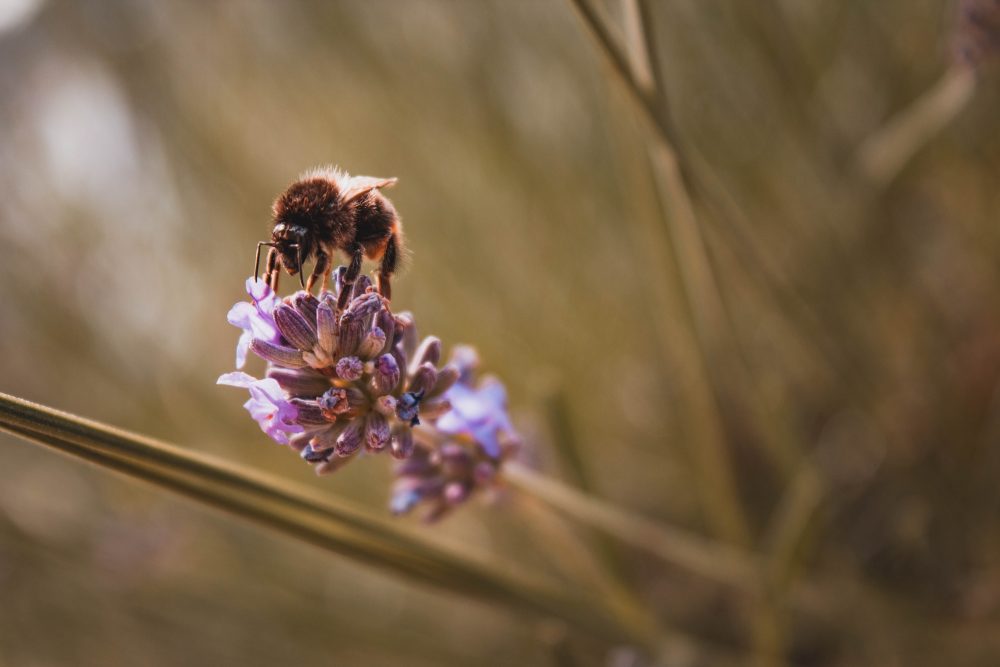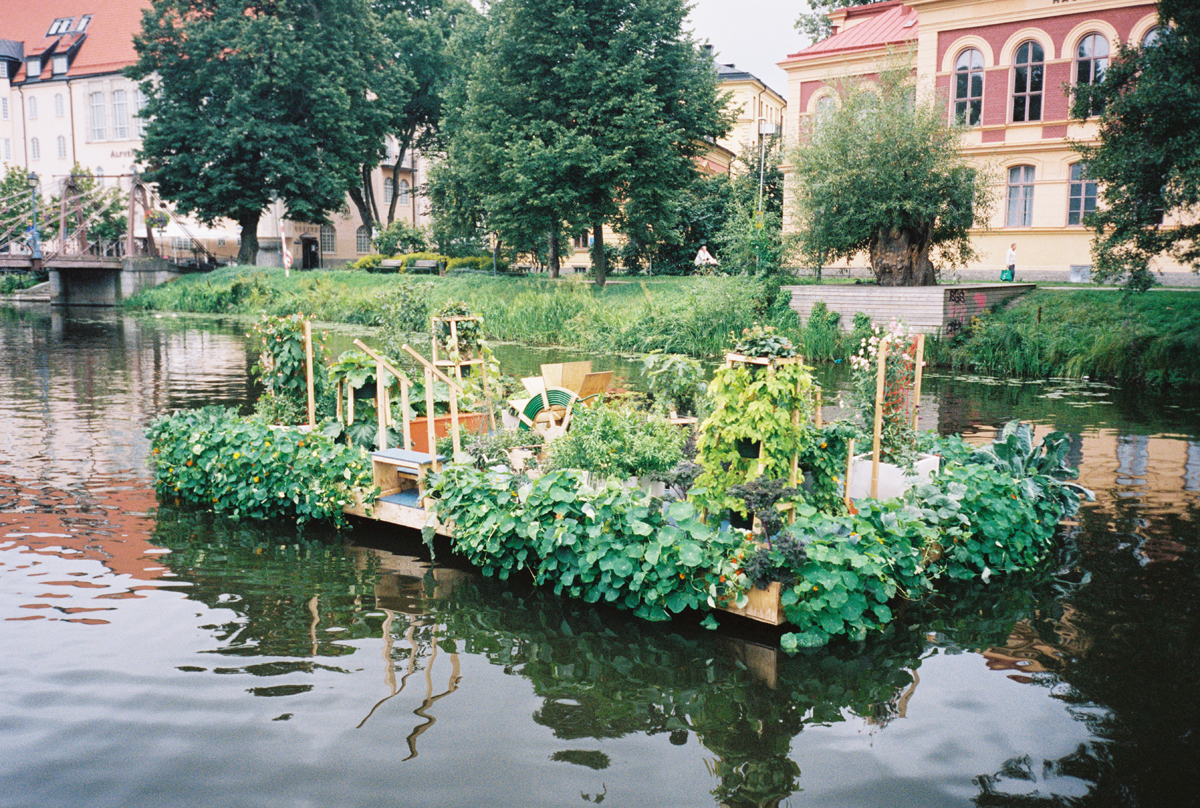Vacant land and urban agriculture are rejuvenating wild bee populations. Bees love cities. What can cities do to love them back?
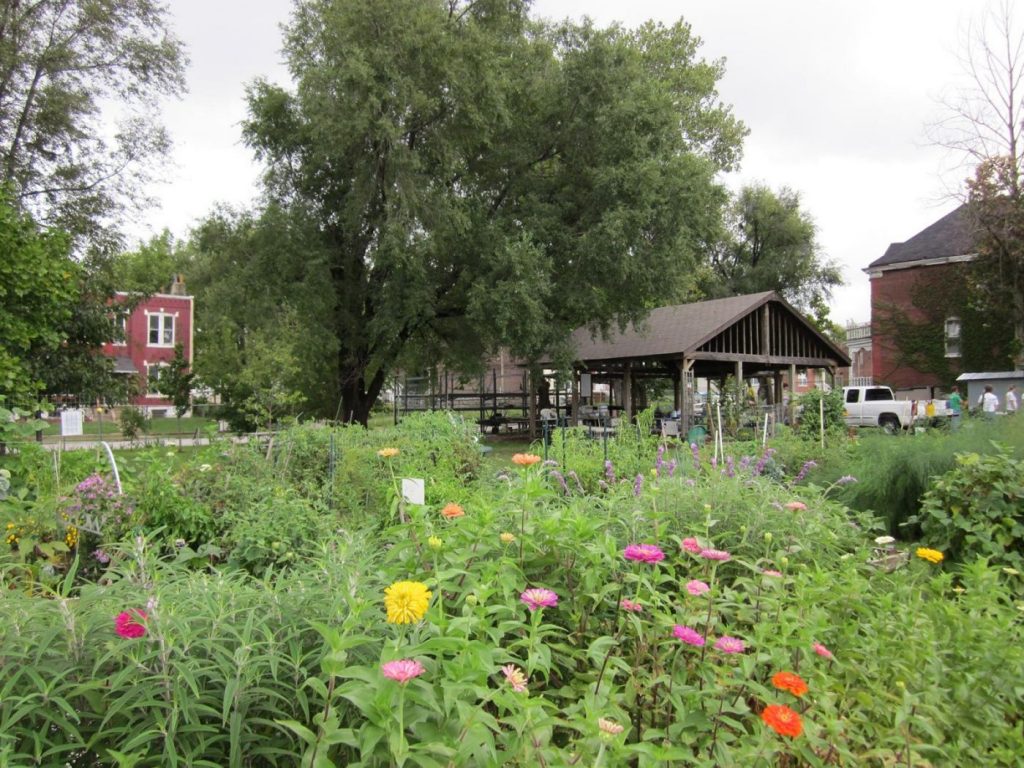
Last summer, Paul Maeillo had to clear a vacant lot in North Philadelphia, and he wasn’t happy about it. He’d done it plenty of times before, as part of the Philadelphia Horticultural Society’s LandCare program, which hires local contractors to maintain the neighborhood’s many abandoned parcels. But on this day the lot was full of wildflowers — and wildlife. In fact, it wasn’t vacant at all. He saw snakes and mice and many, many bees, gathering nectar and pollen from the untamed flora. “Just teeming,” Maeillo remembers. “It was kind of wild.”
The lot was an eyesore to humans, and a feast for pollinators. Maeillo didn’t have much of a choice: he mowed it down. But he left a small wild patch in the center. “It seemed not right to take away all their resources,” he says.
Some of those pollinators were probably honeybees from an urban farm a few blocks away. Others were likely wild. Either way, the presence of bees wasn’t an aberration. Groups of entomologists in the U.S. and abroad have increasingly come to the same conclusion: Bees may actually prefer cities. Bee diversity is much higher in St. Louis than in surrounding rural areas; the same goes for cities in the U.K. At a time when pollinators the world over are struggling, it’s a heartening development, though it comes with a twist. Cities plant pollinator gardens and sign pledges to protect honeybees, and that’s great. But some evidence suggests a surprising environmental correlation to urban pollinators’ health: neglect of land. Bees thrive in cities such as St. Louis and Detroit, which have large tracts of vacant land owing to a steep and steady population decline — a drop of more than 50 percent over the past 60 years.
From our partners:
“People move out, bees move in,” says Gerardo Camilo, an associate professor of biology at St. Louis University. Here, Camilo and his fellow researchers have discovered links between bee diversity and abundance, and a neighborhood’s diversity, density, and wealth. The city’s north side — where wealth is low, human populations have declined precipitously and vacant lots abound — is a prime bee habitat. So is the Middle Corridor, a swath of the city between Delmar Boulevard and Interstate 44 where recent immigrants to the U.S. are planting a wide variety of crops. The least bee-friendly part of St. Louis? The South Side, among the whiter, wealthier, more homogeneous parts of the city. Human diversity, it seems, is good for bee diversity.

And cities? They’re simply another highly specialized ecosystem to which all living things — human, plant, animal, insect — adapt. “If our ecological theory is worth the paper it’s written on,” Cabilo says, “Then the same theories, the same hypotheses, the same models that work on natural ecosystems, they have to also apply in an urban environment. They have to apply in city parks and neighborhoods and community gardens.”
Yet, cities have often gone overlooked in biodiversity discussions. Conservationists often prioritize wild and rural lands. Cities are seen as disruptors of the ecosystem, rather than as part of it. Understandable, considering the extent to which urban development has contributed to habitat loss. But cities have also created new and novel habitats that Camilo thinks conservationists would be remiss to overlook, particularly for bees. The decline of pollinators poses a real threat to our food systems. Bee pollination is responsible for one out of every three bites of food we take. To recognize that bees may flourish in cities and then plan with that in mind — this includes promoting urban agriculture, among other initiatives — could be an urban ecology game-changer, for humans and pollinators alike.

THE DANCE BETWEEN HUMANS AND BEES
Of the many types of bees; 4,000 species are native to the U.S. alone. Honeybees are not among those native species. European colonists introduced honeybees as they did cows, and for the same reason: as livestock, in this case, to harvest honey and beeswax. To this day, honeybees are primarily managed by humans. Honeybees do pollinate some plants — this means they facilitate plant sex, increasing the yield and size of fruit — but they’re not particularly good at it. The real heavy lifting in pollination is done by all those native bees. Many have evolved in tandem with one species of plant, such as the Peponapis pruinosa, which pollinates squash. (Bumblebees are a species subset that can perform “buzz pollination,” a specialized technique.) We owe these bees not just the food on our plates, but the very texture of the world around us.
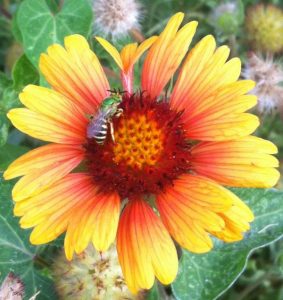
“Bees are the most important terrestrial pollinators in the world,” says Scott MacIvor, an assistant professor at the University of Toronto Scarborough, who studies biodiversity and plant-pollinator relationships in cities,” he says. “When we think of flowers: the colors, the shapes, sizes and heights off the ground and so on, these are a resultant of co-evolution with the local bee communities. When we appreciate gardens, we’re appreciating the evolutionary dance that plants and pollinators have done over time.”
The human contribution to this evolutionary dance has been, in many cases, to silence the music. Nearly one in four native bee species is imperiled, possibly facing extinction. Discussions about bee loss often focus on where they can be most useful to us — pollinating crops. But large-scale agriculture creates a terrible bee habitat. Endless seas of corn and soybeans don’t do much for bees — neither plant requires pollination, so they don’t offer a reward of nectar, which is really what bees visit plants to find. Research points to the widespread use of pesticides (particularly neonicotinoids) and herbicides as another endangering factor. They’ve been linked to colony collapse disorder, a phenomenon in which 30 to 60 percent of bees in a hive die off over winter. Plus, most don’t bees nest together in hives, like honeybees do, but alone, in hollow plant stems or burrowed under the ground. Frequent tilling of farmland disrupts those nests — so we’re losing bees in precisely the place we need them the most.
The suburbs make bad bee habitats for similar reasons. Manicured lawns are a monoculture, replete with weed killers, and constant mowing and yard maintenance leave them no place to nest. Cities, on the other hand, make surprisingly great homes for bees, in part for the same reason they make for interesting people habitats: concentrated variety.
“Differences across the landscape create more niches and more different kinds of habitats, so [different species are] not overlapping their resources and can co-exist,” says MacIvor. “So [contrast] a city that’s really homogenous — think of suburban sprawl — versus a heterogeneous mixture of neighborhoods across Toronto where each neighborhood has different ethnicities, different income levels, density of buildings… It provides more habitat for bee diversity.”
FEWER PEOPLE + DIVERSE FLORA = MORE BEES
At the same time, bees thrive in shrinking cities too — places unlikely to return to their original density. Researchers in St. Louis, which has 25,000 vacant lots, have documented nearly 200 species of bees, among the highest recorded numbers in a North American city. That’s likely not because the city is particularly sustainability-focused, but because vacant lots make for good bee habitat, with their loose soil and weedy plants. Camilo believes poverty also plays a role.
“If you’re poor and you have to provide food for your kids, put food on the table, your concerns with weeds in your yard or growing between the cracks in your driveway, are completely nonexistent,” he says. Residents of lower income neighborhoods are less likely to use weedkiller, and, particularly in parts of the city where abandoned houses outnumber occupied ones, are less likely to clear overgrowth from the lot next door.
A University of Michigan study found a similar and intriguing link. Ph.D. candidate Paul Glaum and fellow researchers surveyed bumblebee populations across five southeastern Michigan cities. In Ann Arbor, Ypsilanti, Dearborn, and Dexter, the pattern was clear. Bumblebee abundance decreased where impervious surface increased.

The effect was striking. The researchers had also sampled at more rural sites, including on a nature reserve at the University of Michigan. There, they found the highest abundance of bumble bees of any site surveyed: 42 specimens/individuals. But to Glaum’s surprise, the second-highest concentration of bumblebees was at a site right in the middle of downtown Detroit: 41 specimens/individuals.
Glaum and his fellow researchers have another theory about what’s fueled the abundance and diversity of bees in Detroit: urban agriculture, a movement that has blossomed in this city at the intersection of opportunity and need. All that abandonment has opened up farming land across the city, while a lack of affordable healthy food options has made urban farming a social and economic cause.
Naim Edwards, who was a graduate student at the University of Michigan during the study, helped connect Glaum and his research team to Detroit urban farms, where they conducted many of their bee surveys. Edwards says whereas ornamental gardens are “usually pretty useless as it pertains to supporting local native pollinators,” urban gardening serves both humans and pollinators.
“It doesn’t matter what you plant. It could be strawberries, potatoes, cucumber, pumpkins, onions, garlic, whatever. We can only eat and appreciate the product of those plants if they go through their life cycle of flowering, and by flowering they give pollinators the pollen that they need to live,” says Edwards. “So it’s a very mutualistic relationship, where we depend on the pollinators for that food, whether we know it or not, and the pollinators depend on us for those plants, whether they know it or not. Neither of us is necessarily intentionally serving the other, but by playing our roles… we’re creating healthier habitats for both of us.”
Camilo found a similar feedback loop between urban gardens and pollinators in St. Louis. The city’s Middle Corridor is not just home to immigrant communities, but a sizable number of community gardens. “You tend to plant stuff that reminds you of home,” says Camilo. Okra and squash from Ethiopian immigrants, chiles and beans from Mexican transplants — the variety of crop cultivation means a more varied diet for bees, or what Camilo calls a “diversity of flowering resources.” Interestingly, according to Camilo’s research, crop yields from Middle Corridor gardeners were larger and more plentiful than crops planted on the city’s south side, where the bee population is less diverse.
HOW CAN CITIES TACKLE POLLINATOR POLICY?
These pollinator developments have evolved largely by happenstance, not by design. Camilo has partnered with the Missouri Department of Conservation to educate residents about how they can create pollinator-friendly gardens. But he and other researchers agree that higher-level interventions are needed. “We can’t go door to door and get a few individuals to plant some more flowers and say that’s going to save the bees,” says Glaum. “This is a community-wide thing that needs to happen.”
Consider this prototype. Toronto, whose green, park-filled metro area is home to more than 300 species of bees, ranks among North America’s “greenest” cities for its sustainability measures. The city council adopted a “Pollinator Protection Strategy” that includes creating more pollinator habitat on public lands, sharing lists of recommended plantings for home gardens, and linking up green spaces so pollinators can more easily travel between them. It’s a strategy geared specifically to native bees, and it builds on years of policy that aim to green the city while recognizing that already booming Toronto will only get more dense. Since 2006, the city has mandated that certain new buildings install green roofs. The Pollinator Protection Strategy would mandate that those roof plantings take pollinators into account.
So one of the first steps for turning cities into bee-friendly ecosystems is to advance the research. Urban biodiversity is a relatively new field of study; in many cities, bee diversity and abundance have not yet been measured. Getting a finer-grain understanding of what helps them thrive could improve city decision-making.
“For example, we’re going to plant street trees. But we have a lot of choices about which street trees we plant,” says Douglas Sponsler, a postdoctoral researcher at Penn State University who is studying Philadelphia’s bees. He’s in the early stages of conducting a survey to determine which kinds of pollen Philadelphia’s honeybees and wild bees are collecting, to “see if we can learn something about how different forms of urban land use affect the plants the bees are foraging on,” he says. For example, are honeybees with downtown hives gathering primarily from Linden trees planted by the city? Or are they flying out to vacant lots in North Philadelphia to forage from weeds?
Understanding what’s made urban areas so good for pollinators will also help researchers figure out what role cities can play in their larger, regional ecosystems. Because, after all, while pollinators are key to the success of urban agriculture, the fact remains that most of our food is grown outside of cities, and we need bees to thrive there, too. Camilo is also talking to city officials about creating “pollinator corridors,” continuous stretches of bee-friendly flora that would encourage bees to commute out of the city towards agricultural lands.
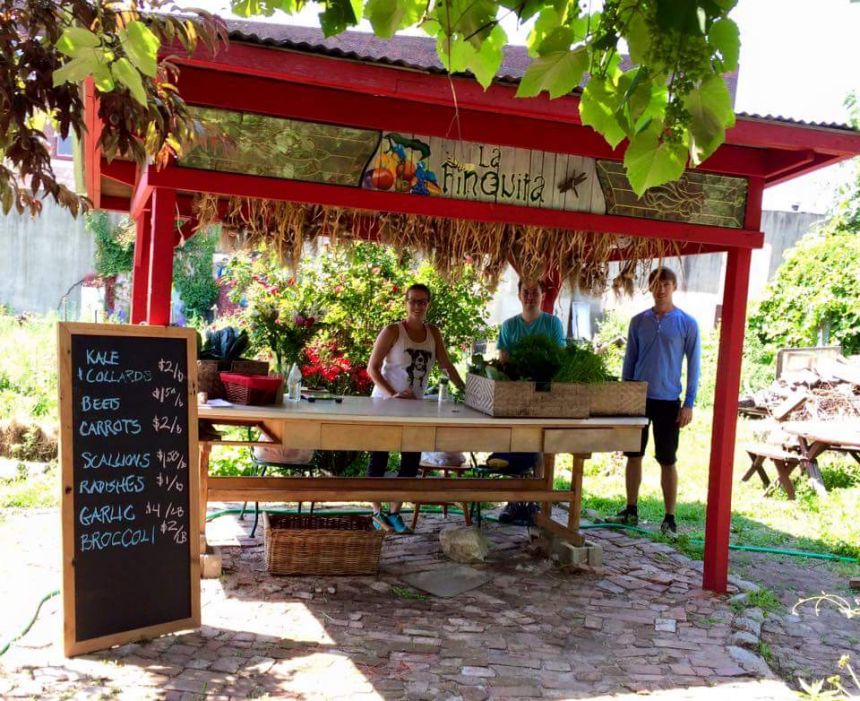
Edwards, too, wants to see cities take a more intentional approach to pollinator protection. While community gardens have measurable positive effects on neighborhoods, untended vacant lots have been shown to contribute to stress. Edwards is heartened by the recent announcement that world-renowned garden designer Piet Oudolf will be creating a garden in Detroit. Oudolf often uses native plants, which are frequently good for bees.
“A vacant lot or an unmaintained lot, by default, will have a variety of native plant species that naturally disperse there,” says Edwards. “But if that same lot was intentionally stewarded by human beings, [it] has the potential to exponentially increase not only the pollinator population but all kinds of birds and even some kinds of mammals.”
Formalizing existing gardens and farms that have cropped up on vacant land will be particularly important as development continues its slow uptick in Detroit. “These parcels of land that are being used by organisms who do pollination have an active value within the community and [should] not necessarily just be considered blight,” says Glaum. These spaces are worth something, he says, even though right now, their value doesn’t square neatly with property values.
REAL ESTATE BOOMS AT THE EXPENSE OF GREEN SPACE
That’s especially true in cities such as Philadelphia, where population also declined over the past 50 years, but less dramatically. The city is now rebounding. Whereas Detroit and St. Louis are considering “smart shrinkage” policies that would embrace a smaller, greener city with more open land, Philadelphia’s vacant lots — and its community gardens — are disappearing.

In other words, Finquita was part of a rarely-acknowledged urban ecology, one that encompassed the human and the non-human alike. Last summer, beekeeper Abby Fretz installed two hives of honeybees there. Though they’d started out fairly weak, the bees thrived, producing honey late into the fall. It was a rough, long winter, but when Fretz checked on the bees in spring, they were bursting with good health. “I really think it was the location,” she says.
But at the end of April, Fretz had to move the bees to a new spot, because Finquita is no more. The gardeners who founded it had taken over a lot belonging to an abandoned tire factory. With vacant land all around, and property values virtually nil, no one bothered them for decades. But today, new construction sprouts in every direction, and La Finquita suddenly sits on valuable land. Two years ago, a developer found a far-off shareholder from that long-defunct tire company, and convinced them to sell the lot for $30,000.
Now the farm, and the bees, will be gone, leaving a hole in the neighborhood ecosystem. No more dirt-cheap produce, no more honeybees pollinating nearby gardens, no more intergenerational, intercultural gathering place. “Nothing will replace this space in terms of the community or farming value,” says Jessica Noon, one of Finquita’s main volunteers.
There are mechanisms in Philadelphia to try and preserve gardens, but Finquita hasn’t been the only venture to face this risk and lose. A recent book on Philadelphia’s urban agriculture movement, by Temple University professors Christina D. Rosan and Hamil Pearsall, boils down the threat to urban farms this way: Now that real estate is rebounding in Philadelphia, city officials, concerned with property taxes and growth, generally see “vacant” land for its “exchange value” — what it can fetch on the market. They might see urban farms as temporary placeholders until the land gets sold. Gardeners and neighbors, on the other hand, more often see these lots for their “use value” — what having a collectively-managed green space means in people’s lives.
“What we choose to do with those [lots] is going to have an enormous ecological impact because a lot of the green space in this city is vacant lands,” says Sponsler.
RESPECTING ALL CREATURES, GREAT AND SMALL
Facing similar questions in Detroit, Edwards suggests that cities acknowledge the work urban gardeners have done to improve their neighborhoods, and give them more avenues to protect their plots from sale or development. He also recommends that we expand our definition of land’s “use value” to include pollinators, and other creatures besides humans. If\, we can do that, he thinks, we’ll actually learn to treat each other better, too. Edwards, who is currently the director of Michigan State University’s Detroit Partnership for Food, Learning and Innovation, sometimes gives a presentation on pest management to urban gardeners, in which he hammers this home.
“I have a slide where I put up a picture of a roach and a snake and a spider and a rat and a tick, and then I ask people what you think about when you see these things. And people say like, ‘Oh I hate them. Oh they’re dangerous. Not in my house. If I see it I kill it. They don’t belong here, and blah blah blah.’ And then I pause and I look at them and I smile and I’ll say, ‘Everything you said. It’s something that someone has said about a Jewish person or a black person or a Muslim person or an immigrant or Mexican.’ And people kind of pause and they’re like, ‘Oh no, what does that mean about me.’”
The point, says Edwards, is to help people realize all the ways in which we already share the city, and how we could do so more equitably. It’s easy to see why we should care about bees — they help out humans. But to really promote biodiversity and conservation in cities, urbanites have to be willing to share space with creatures of all kinds, whether or not we understand their value.
This article is written by Jen Kinney and originally appeared in NextCity.






